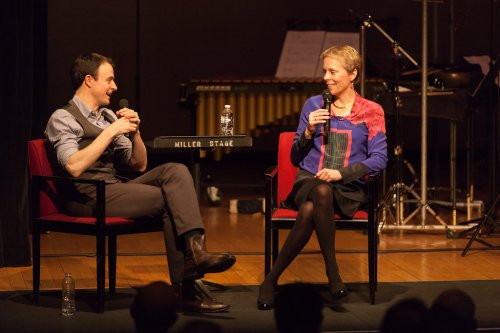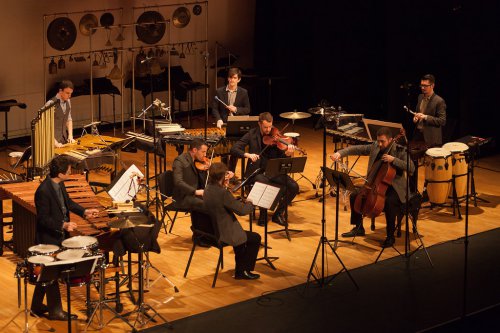Composer Portraits: Augusta Read Thomas, with JACK Quartet and Third Coast Percussion
An extraordinary and intimate evening of dazzling contemporary music for strings and percussion.

Composer Augusta Read Thomas as she was interviewed by percussionist David Skidmore at Miller Theater on March 5, 2015 (Photo credit: Karli Cadel)
[avatar user=”Jean Ballard Terepka” size=”96″ align=”left” ] Jean Ballard Terepka, Music Critic[/avatar] Augusta Read Thomas’ music is stunningly, exhilaratingly rich. Her imagination combines luminous expansiveness and crystal sharp harmonic and rhythmic precisions; her music is physical and spiritual, brainily intellectual and deeply, profoundly felt.
Recently, as part of the Miller Theater at Columbia University’s Composer Portrait series, Augusta Read Thomas was briefly interviewed between performances of recent and new works for string quartet and percussion. The first half of the program featured the world premiere of Capricci for violin and viola (2014) and of Selene for percussion quartet and string quartet (2015) as well as “Invocations” from Sun Threads for string quartet (1999). The second half of the program began with an informal interview between Thomas and percussionist David Skidmore and then concluded with the New York premiere of Resounding Earth.
Throughout the evening, JACK Quartet’s musicians – Christopher Otto/violin, Ari Streisfeld/violin, John Pickford Richards/viola and Kevin McFarland/cello – and Third Coast Percussion’s Sean Connors, Robert Dillon, Peter Martin and David Skidmore were dazzling. No matter what their instrument, these musicians managed the exquisite balance of absolute control over even the most appallingly difficult material and a fearless ability to let Thomas’ music be radiantly alive, dancing and setting listeners’ nerves to excitement. There is also in these musicians – in each of the two quartets as well as in their two-group collaboration – a kind of intense, high-wire faith in the music and each other that makes them well suited to the combined rigor and optimism of Thomas’ compositions.
The opening piece of the evening was the shortest. The five minute violin–viola duet, a recent adaptation of a 2011 wedding present originally scored for flute and clarinet – is indeed about how loving, opinionated, and sometimes cantankerous people talk to each other, mirror each other, anticipate and finish each other’s thoughts, drift away and come back in a wise trust that never violates individual identity. The duet feels like a particularly edgy, urban, witty and quite sexy marriage, destined for longevity.
This opening piece was about human impulses, but the rest of the evening’s works concerned themselves with the workings of earth and cosmos, beginning with one section, “Invocations,” from Thomas’ 1999 string quartet, Sun Threads. Urgent and dense, this music is about rhythms, tones, notes and chords all calling, reflecting, interrupting and anticipating each other. This was Thomas’ first writing for string quartet, but it was already confident and sure.
Immediately after “Invocations” came the world premiere of Selene for string quartet and percussion quartet.

The combined JACK Quartet and Third Coast Percussion as they performed the music of Augusta Read Thomas at Miller Theater on March 5, 2015 (Photo credit: Karli Cadel)
The “subject” of Selene – its immediate inspiration – is the ancient Greek goddess of the moon. In the concert’s extremely useful program notes by Paul Griffiths, the silvery, quixotic moods of the moon are illuminated by reference to Homer’s salutation, “Hail, white-armed goddess, Selene, mild, bright-tressed queen!” The eighteen-minute work is not divided into movements, but into fast and slow sections, each increasingly short in duration as the work progresses. The music – strings deployed with an exploitation of all their sounds from percussive to sensuous, and a wide variety of keyed and non-keyed percussion instruments (including vibraphone, xylophone, marimba, bongos and chimes) – is a richly textured exploration of the imagined feel of the moon’s influences and movements: it is an examination of silveriness and shimmer, pause, movement and gradual waning, where the piece ends. As the music approaches its conclusion, becoming increasingly otherworldly, the audience remembers the work’s opening sturdiness and knows the moon will wax again.
By itself, Selene would have been cosmic mistress of the evening … but the major work of the second half of the evening, presented after the Skidmore—Thomas interview, Resounding Earth (2012) in its New York premiere was the night’s stunning star.
In conversation, Thomas said – ruefully, slyly and proudly – Who ever would listen to thirty minutes of music “made only of metal?” In fact, anyone … all of us. Resounding Earth is gorgeous.
Discussing the development of Resounding Earth, Thomas described a complex and elaborate composing and workshopping process of listening to every instrument’s sounds, recording them, and then experimenting with them to write the music. She talked about composition as a physical activity – she stands and moves as she writes – and she is “constantly scatting.” She described herself as being very particular about musical sounds, about “wanting this sound, not that one,” and being fascinated by percussion instruments’ unique ability to begin with their own individual crash, creating sounds and tones that then possess their own life, vibrating in their unique “envelopes.”
Resounding Earth‘s musical and intellectual architecture is extremely rich, dense and complex. Listening to it is an experience of surrender to all the ways that sound can inhabit space: sometimes loud, sometimes delicate; sometimes wildly noisily and sometimes in waves of whisper; sometimes in ceremony and sometimes in surprise. Each movement explores enduring legacies of individual composers whose ideas inhabit Thomas’ awareness; these include Messiaen, Stravinsky, Boulez, Legeti, Partch and Cage. Each movement is double-titled: they are Invocation–Pulse Radiance, Prayer–Star Dust Orbits, Mantra–Ceremonial Time Shapes, and Reverie–Crystal Lattice. It is a heady alchemy.
Thomas said, “I sculpted and sculpted and sculpted.” She worked with musical sound as sculptors work with their clay. The process is about the elements themselves. Creating for and with these metal instruments, Thomas considered their origins: before metal was found on the earth, it dropped from the sky, and only then was made into objects of utility and beauty.
For all the cerebral pleasures of Resounding Earth – even the title has at least two meanings: the earth itself makes sounds as sounds circle the earth – its gifts are deeper. It is a piece about origins and possibilities; it is about the ways in which physical being is in fact spiritual; it is about the ties that connect earth and empyrean.
The evening with Augusta Read Thomas, her music and the eight stunning musicians who realized her music so marvelously was remarkable: it transformed the experience of listening into an opportunity to explore the nature of artistic creation.
Composer Portraits: Augusta Read Thomas, with JACK Quartet and Third Coast Percussion (March 5, 2015)
Miller Theater at Columbia University, 2960 Broadway at 116th Street, in Manhattan
For more information: call 212-854-7799 or visit http://www.millertheatre.com or http://www.augustareadthomas.com
Running time: two hours including one intermission
An extraordinary and intimate evening of dazzling contemporary music for strings and percussion.






Leave a comment